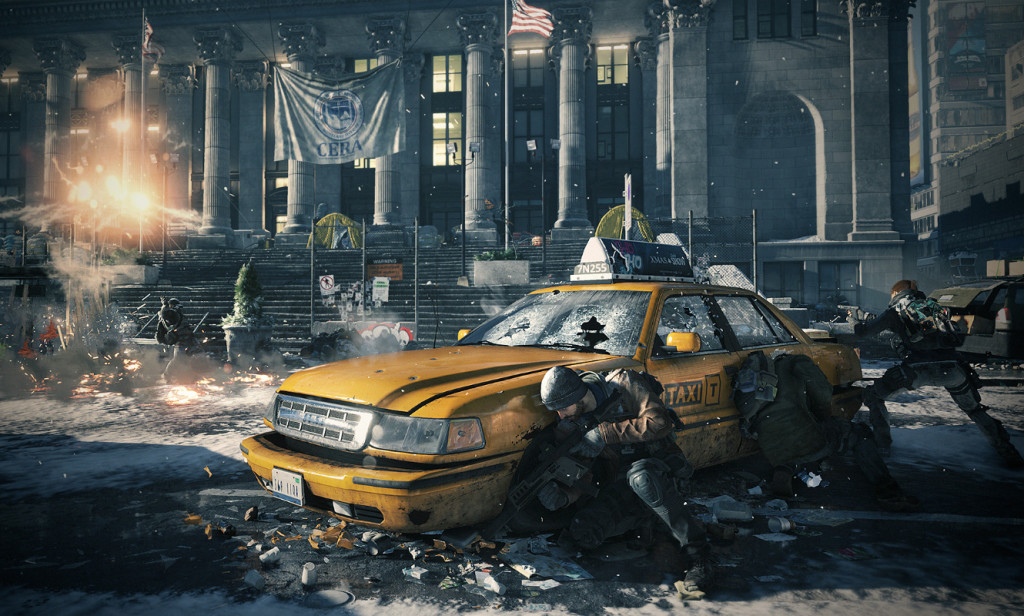Close Quarters Anarchy: Megacity Warfare Brought to Life in The Division

The faces looking through the chain link fence don’t despair any more. They gave up days ago. That’s why they are in the Hudson Refugee Camp, packed in by the thousands just to be close to what was supposed to be salvation: soldiers, medicine, communication links to the rest of America. The truly desperate remain outside, fighting over canned food and fresh ammunition. Even if you want to help the refugees, you can’t. You’re needed on the streets of the catastrophe that is New York to help restore order.
This is Manhattan as seen in the early-play version of Tom Clancy’s The Division, a new video game in the Tom Clancy series that follows a small team of covert operators who have been standing by in the event of a catastrophe so great that the United States teeters toward becoming a failed state. In this case, it is a bio-terrorism attack on Black Friday that ruptures the fragile membrane between order and anarchy.
While the game will not be out until March 8, there has been a lot of interest in this very dark and realistically rendered vision of collapse. More than 6 million people have played the beta version of the game, according to gaming site IGN. This is roughly equivalent to the population of Manhattan, Queens, and Brooklyn put together.
According to the game’s maker Ubisoft, this was the biggest beta test ever.
The Division is an open-world game, which means it is a curated, expansive environment that is explored in real time with other players. There is a storyline, which is even backed up by a short movie. But as a player you have to decide what is most important to do next: restoring a medical clinic first or reestablishing military checkpoints? Or you can enter a no-holds-barred quarantine area called the Dark Zone and take on other players in hopes of stealing their equipment and supplies. All this game play is from a third-person perspective, which allows your character to use the surroundings for cover and concealment while offering a fuller point of view. There is urban devastation today in Syria that eclipses anything rendered in this game, but this New York-based simulation offers a vivid visual and cultural connection with unsettling familiarity.
The decaying and hyper-violent collapsed Manhattan is rendered painfully well. Everything is turned on its head: Police are the victims, soldiers are outgunned, and doctors become hostages of local warlords. Yet the crisis still feels fresh, which gives players a sense that there is hope to stave off or even reverse further horrors. You find recently abandoned Army front-end loaders in the middle of the street, their shipping containers held high like ignored offerings. Snow falls on bullet-riddled taxis. Scavengers either ask for help or limp away at the sight of a gun.
Playing The Division is like looking through a window into the collapse of the megacity. Considering the focus the U.S. Army and the Marine Corps have on megacities, The Division represents a chance to have a much-needed conversation about this future operating environment. “It is inevitable that at some point the United States Army will be asked to operate in a megacity, and currently the Army is ill-prepared to do so,” wrote Army officials in a 2014 report on megacities. The Division could be important to the different generations within each service given the expected popularity of the game. Given the Defense Department’s reinvigorated interest in wargaming, a big multiplayer environment like this one is especially relevant — and troubling. Colonels and generals need to play this game, not just their younger comrades who salute with one hand while texting with the other.
Cultural landmarks like stadiums where thousands once gathered become personal fiefs for gangsters and warlords. Towering buildings that once sheltered families are deathtraps. Were the game set in a rural environment, it would have an altogether different feel. Individualism might triumph as a test of spirit or will over nature. But scavenging in the confines of the New York subway system or winding up in a shootout with a local gang reinforces that your own worst enemy is all too familiar: fellow humans. The game lays bare how the odds are stacked against the survivors of such a calamity, and how even functional complex urban environments teeter and sway between chaos and order each day. Just as the novel World War Z by Atlantic Council senior fellow Max Brooks presents this uncomfortable truth through the premise of a zombie outbreak, this video game does so with close-quarters anarchy caused by catastrophic bio-terrorism. While it is not as haunting as the 2015 Polish game This War of Mine that explores war purely from a powerless civilian’s perspective, it comes close. Moreover, The Division will appeal more broadly to gamers, given its formulaic progression of acquiring skills, weapons, and powers, which big studio games must incorporate in order to entice millions of players.
That is also one of its strengths and perhaps greatest forms of utility in the defense realm: broad appeal. Megacity operations, be it relief or combat, will no longer be an abstract concept to young corporals or privates — or their commanding officers. They too will have looked through the fence at the lost faces in the Hudson Refugee Camp.
August Cole is the director of the Atlantic Council’s Art of Future Warfare project and a non-resident senior fellow at the Council. He is a writer, consultant and analyst. His first novel, GHOST FLEET, co-written with Peter W. Singer, was published in 2015.

